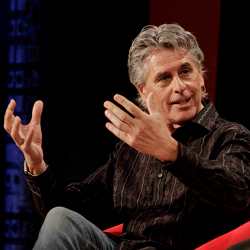
A deep interest in the question "what is information?" led mathematician and popular science writer Keith J. Devlin from formal logic to applications used by the U.S. Central Intelligence Agency (CIA) to the founding of BrainQuake, a San Francisco-based company that makes educational video games to teach children mathematics in a dynamic way.
“I founded the company when I was 65,” said Devlin, “so I am probably one of the oldest persons in Silicon Valley with a start-up company.”
Apart from his academic work in mathematics and logic, which includes his activities as a senior researcher and executive director of H-STAR, the Human-Sciences and Technologies Advanced Research Institute at Stanford Universityy, Devlin is also known as “The Math Guy” on National Public Radio, has his own blog on The Huffington Post, and has written numerous popular science books, like The Math Gene: How Mathematical Thinking Evolved and Why Numbers are Like Gossip (2000) and The Man of Numbers: Fibonacci's Arithmetic Revolution (2012).
Born in Great Britain, Devlin has worked at Stanford University in California since 1987. Now 69, he holds both British and U.S. citizenships. I spoke with him in Amsterdam, where he had been invited to give the keynote lecture at the 25th anniversary symposium of the Institute for Logic, Language and Computation (ILLC).
Let me start with the young Keith Devlin. How did you become interested in computing?
When I was 17, in 1964, I did an internship at British Petroleum (BP). The company used an Elliott 803 mainframe computer to do sales forecasting. Although my job was only to do the data entry, I taught myself the Algol programming language they were using. Soon I found that the machine was giving suspicious results. I discovered a bug in the program, and fixed it. My supervisors at BP were staggered. Looking back, it was fun having experienced an age where programming a computer meant going into the machine.
After that, you devoted many years to mathematical logic. What brought you back to computing?
That was when the Apple Macintosh came on the market in 1984. Suddenly, we had ‘paper on steroids.’ I immediately realized that this was going to be big. The Mac greatly increased my already-growing interest in the notion of information and the application of logic to how people understand natural language. Take the following two sentences: ‘The baby cried. The mother picked it up.’ Everybody understands the meaning, despite all the ambiguity. How do people do this? Together with a sociolinguist, Duska Rosenberg, I developed a successful methodology to analyze everyday linguistic data like this. From all the work I have done, this is what I am most proud of.
We all know that classical logic was important in developing the concept of digital computing, but what does logic have to offer modern-day computing?
Logic especially has a lot to offer to information analysis, but you need to apply it in a smart way. Formal logic is like a precision tool, a very sharp needle that you can stick very deep inside a problem. It works very well for analyzing mathematical and engineering problems, but much of the real world is more messy. In the real world, it is often not possible to find the one and only answer; the goal is to try and find a better answer than the best one you have so far. We can use formal logic to explore different aspects of the problem: make a little prick here, give a little prick there. In this way we scattershot the problem to get more and more information. Just as putting down stepping stones in a river gives you places where you can step confidently as you try to find your way across, so too logic can provide small islands of firm knowledge as you move around the problem, increasing your understanding and thereby the reliability of your answer.
How did you come to work for the CIA?
After 9/11, there was an instant and big response from the CIA; they recruited a lot of academic experts to help in connecting all the dots in the huge amount of data they had. I received a call from a subcontractor of the CIA; they asked me to help with building a model for human reasoning and communication. The work I was doing on understanding natural language suddenly became very relevant in preventing terrorist attacks.
How did that lead to founding a company to make educational video games?
After the CIA project, I used a similar type of logic for analyzing video data that the U.S. Navy received from their drones. Filtering video data is even more difficult than filtering language data, but again, logic helps you navigate an ocean of data by putting stepping stones in the right places.
Now, imagine kids sitting in the classroom trying to learn mathematics. They are really like intelligence officers trying to connect the dots in an ocean of data. Our video game company BrainQuake tries to open up mathematics to far more people than you reach by only teaching mathematics in the traditional symbolic way. Human thinking is very dynamic, and tablet computers and video games can get kids closer to this. Learning mathematics using video games like ours is very different from learning from a textbook, in the same way that learning music by playing an instrument is very different from learning music by reading an instruction book.
Bennie Mols is a science and technology writer based in Amsterdam, the Netherlands.



Join the Discussion (0)
Become a Member or Sign In to Post a Comment